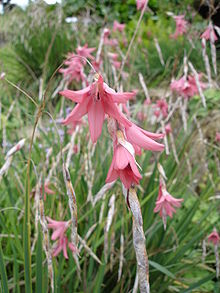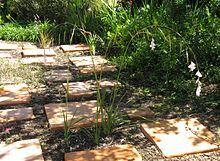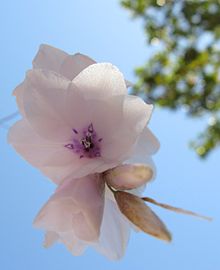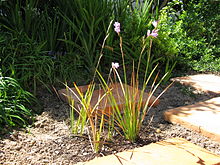- Dierama
-
Dierama 
Dierama igneum Scientific classification Kingdom: Plantae (unranked): Angiosperms (unranked): Monocots Order: Asparagales Family: Iridaceae Subfamily: Ixioideae Tribe: Ixieae Genus: Dierama
K. KochType species Dierama ensifolium
Koch & BouchéSpecies See text
Dierama is a genus in the Iridaceae. Its common names are not stably established, but various species are loosely known by names such as as Fairy's Fishing Rods, Fairy's Wands, Fairy Bells, Wedding Bells, Hairbells, Harebells. These refer to the bell-shaped flowers on slender scapes that bend gracefully under the weight of the inflorescences and nod in the wind. The various species and cultivars produce flowers in ranges of colors from white through dark red, some of them with spots of yellow or blue.[1]
Contents
The genus Dierama
Dyer cites the following authorities for the description of Dierama: K. Koch in Ind. Sem. Hort. Berol. App. 10 (1854); Bak. in FC. 6 86 (1896); in J. Roy. Hort. Soc. 54 : 193 (1929)[2]
Dierama is a genus in the family Iridaceae. Members of the genus are evergreen geophytes growing from corms that often form chains underground in a manner similar to several other Iridaceae such as Crocosmia. The corms are relatively large, flattened ovoids in shape, with tough, fibrous tunics. A corm bears several leaves in an erect bunch; the leaves are linear, slender, evergreen, flat, fibrous and tough. The scapes are slender and wiry, branched, more or less bent at the apex by the weight of the inflorescences they bear; the resulting effect suggested some of the common names. Each inflorescence is in the form of a lax spike. The outer bract at the base of each flower is dry and papery, often lacerate near its apex, pale with brown streaks; the inner bract is similar but smaller.
The perianth is pendulous, campanulate and actinomorphic; tube short, infundibuliform; lobes enclose the stamens and style, sometimes with their tips recurved. The stamens are erect and placed symmetrically. The ovary is small and the style slender, with three short recurved branches. The fruit capsule is ovoid, somewhat shortened, and firm-walled. There are few seeds, hard, round, and shiny.
Etymology
The genus name is derived from the Greek word dierama, meaning "funnel", and alludes to the shape of the flower.[3]
Distribution and conservation status
The genus includes about 50 species that occur in various, mainly Eastern regions in Africa, ranging from central African highlands to the Cape. In some countries, such as South Africa, all the indigenous species, such as Dierama pendulum are protected, and their survival is not of urgent concern; fortunately there seems to be little interest in the genus for indigenous medicine, or other traditional uses, but population pressure might present threats to many species as more habitats are claimed for residential or agricultural purposes.
Cultivation
Dieramas are effectively evergreen, and retain some foliage throughout most winters in temperate zones, though many species have a partly dormant season in which their leaves show little sign of activity. However, this does not mean that they should be treated like some related garden geophytes such as say, many of the Iridaceae, including Crocosmia, deciduous Watsonias and Gladoli; even in their partial dormancy their roots and leaves remain alive at a low level of activity and accordingly the corms should not be removed from the soil and dried out in sheds, because their roots will die, and so will the bulbs if they are not returned to the soil soon enough. The corms should not be seen as an over-wintering stage, though their partial dormancy is the most convenient time for transplantation and propagation by splitting. If they are grown in regions of heavy frost or moderate snow, they are best kept in the soil under straw in winter, or in frigid zones they may be planted in pots that can be brought into shelters in winter.
Species
The following list includes most of the known species, though several are open to discussion and more certainly await description:
- Dierama adelphicum [4]
- Dierama ambiguum [4]
- Dierama argyreum [4]
- Dierama atrum [4]
- Dierama cooperi [4]
- Dierama dissimile [4]
- Dierama dracomontanum [4]
- Dierama dubium [4]
- Dierama elatum [4]
- Dierama erectum [4]
- Dierama floriferum [4]
- Dierama formosum [4]
- Dierama galpinii [4]
- Dierama gracile [4]
- Dierama grandiflorum [4]
- Dierama igneum [4]
- Dierama insigne [4]
- Dierama jucundum [4]
- Dierama latifolium [4]
- Dierama luteoalbidum [4]
- Dierama medium [4]
- Dierama mobile [4]
- Dierama mossii [4]
- Dierama nebrownii [4]
- Dierama nixonianum [4]
- Dierama pallidum [4]
- Dierama palustre [4]
- Dierama pauciflorum [4]
- Dierama pendulum [4]
- Dierama pictum [4]
- Dierama pulcherrimum [4]
- Dierama pumilum [4]
- Dierama reynoldsii [4]
- Dierama robustum [4]
- Dierama sertum [4]
- Dierama trichorhizum [4]
- Dierama tyrium [4]
- Dierama tysonii [4]
References
- ^ Hilliard, O. M.; Burtt, B. L. (1991). Dierama: the Hairbells of Africa. Randburg: : Acorn Books. ISBN 1874802017.
- ^ Dyer, R. Allen, “The Genera of Southern African Flowering Plants”. ISBN 0 621 02854 1, 1975
- ^ Manning, John; Goldblatt, Peter (2008). The Iris Family: Natural History & Classification. Portland, Oregon: Timber Press. pp. 91–93. ISBN 0-88192-897-6.
- ^ a b c d e f g h i j k l m n o p q r s t u v w x y z aa ab ac ad ae af ag ah ai aj ak al Arnold T.H., de Wet B.C. (Eds), Plants of Southern Africa: Names & Distribution, MEMOIRS OF THE BOTANICAL SURVEY OF SOUTH AFRICA No. 62, Pub.National Botanical Institute, South Africa.1993 ISBN 1-874907-03-X

This Iridaceae article is a stub. You can help Wikipedia by expanding it.




